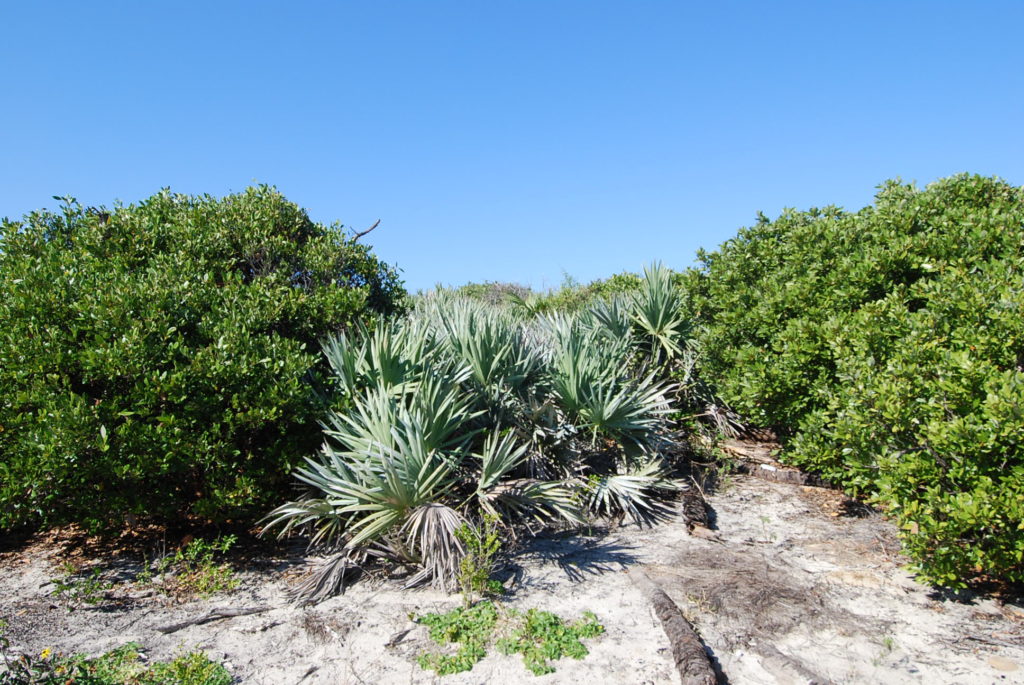
Red Bay
Persea borbonia
There are three kinds of Red Bay in Florida. The first is Scrub Red Bay or Silk Bay, Persea borbonia var. humilis. It is shown on the left and right of this picture and is found in the lower areas of scrub habitat.
This is a dense tree up to 30 feet. It occurs primarily in South and Central Florida and may have leaves with a light to dark coppery underside.
Along the coast is a tall Red Bay, Persea borbonia, with leaves that have a light green underside. It may reach a height of 50 feet.
Inland swamps contain Swamp Bay, Persea palustris. The leaves are slightly larger than the other two and are a light whitish green color underneath. All have leaves that are around four to five inches long. Red Bay and Swamp Bay occur from Delaware south through most of Florida.
Swamp Bay is the only one that requires moist soil, although it can tolerate average soil with organic matter once established. The Silk Bay shown in this picture is growing in dry soil within Juno Hills Natural Area in northern Palm Beach County. This is a rare site where scrub and coastal habitat meet.
Redbay Ambrosia Beetle-Laurel Wilt Pathogen is a new beetle pest carrying a fungal disease that kills Red Bays and Avocados. This beetle arrived here from India in 2002, hitching a ride in packing material.
Older trees die soon after the beetle bores into the trunk and spreads the fungus carried in its mouth into the sapwood. The beetle larvae feed on this fungus. Look for frass coming out of the trunk and dark brown leaves. Click for more info.
The beautiful Palamedes Swallowtail Butterfly larva feeds on young Red Bay leaves. It is important to have these trees available to them or we could lose these butterflies as well.
Although many naturally occurring Red Bays are dying from Laurel Wilt, I feel that Red Bays planted in far flung locations, such as in yards miles from the coast or natural wetlands may escape infestation. You will want to be far from Avocado trees or groves too, so as not to provide a possible pathway to these food trees.
So please don’t avoid planting Red Bays because of the possibility of this disease. We may need the seeds of your trees later, when the disease has passed through and reforestation of Red Bays commences.
The leaves of Red Bay can be used instead of commercial bay leaves in cooking. Wreaths made of them provide a pleasant aroma at Christmas time. The bark provides good support for air plants and orchids the way Live Oak does.
Try planting Red Bay instead of or with Live Oak. It looks similar, yet has a darker brown bark and larger leaves. The pea sized fruit, that looks like a small Avocado, is eaten by birds and is harmless, yet not tasty to humans. The insects found on the leaves and hidden in the bark are food for young birds. Native insects cause little noticeable damage.
Persea borbonia, which is the larger of the three, occurs along the coast back far enough to avoid much salt air and saltwater flooding. It mixes well with other coastal trees and shrubs. Try combining it with Live Oak, Paradise Tree, Pigeon Plum, Mastic, Lancewood, Sea Grape and Hackberry.
The understory can be Wild Coffee, Marlberry, Snowberry, Coontie, Spanish, White and Simpson Stopper, Boston Fern and Red Salvia.
Swamp Red Bay goes well with Red Maple, Virginia Willow, Laurel Oak, Cypress, Slash Pine, Buttonbush, Carolina Willow, Sweetbay, Giant Leather, Swamp, Marsh and Hottentot Ferns.
Silk Bay looks great with Hercules Club, Saw Palmetto, Tough Bumelia, all of the Scrub Oaks, Wild Lime, Wild Coffee, Scrub Palmetto, Necklace Pod, Blolly and other scrub species.